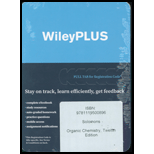
Practice Problem 2.1
Propose structures for two constitutional isomers of cyclopentene that do not contain a ring.

Interpretation:
The structuresfor two constitutional isomers of cyclopentene, which do not contain a ring, are to be proposed.
Concept introduction:
When two molecules have the same molecular formula, they are called isomers. If the connectivity of atoms is different, they are called constitutional isomers.
Constitutional isomers are the isomers in which the molecular formula remains the same but the arrangement of groups or atoms are different in structure.
In order to estimate the number of constitutional isomers of a particular compound, count the number of each atom and arranged all the atoms in different ways.
Answer to Problem 1PP
Solution:


Given: The structure of cyclopentene is as follows:

Explanation of Solution
The structure of cyclopentane contains 5 carbon atoms and 8 hydrogen atoms. Thus, the molecular formula of cyclopenteneis

The molecular formula is
Hence, the two constitutional isomers of

Want to see more full solutions like this?
Chapter 2 Solutions
ORGANIC CHEMISTRY-WILEYPLUS ACCESS PKG.
Additional Science Textbook Solutions
The Cosmic Perspective (8th Edition)
Human Biology: Concepts and Current Issues (8th Edition)
Campbell Biology: Concepts & Connections (9th Edition)
Human Anatomy & Physiology (Marieb, Human Anatomy & Physiology) Standalone Book
Chemistry: An Introduction to General, Organic, and Biological Chemistry (13th Edition)
Introductory Chemistry (6th Edition)
- Several square planar complexes are known for Gold (III) ions but not for Silver (III) why?arrow_forwardAiter running various experiments, you determine that the mechanism for the following reaction is bimolecular. CI Using this information, draw the correct mechanism in the space below. X Explanation Check C Cl OH + CI Add/Remove step Click and drag to start drawing a structure. 2025 McGraw Hill LLC. All Rights Reserved. Terms of Use | Privacy Carrow_forwardComplete the reaction in the fewest number of steps as possible, Draw all intermediates (In the same form as the picture provided) and provide all reagents.arrow_forward
- Please provide steps to work for complete understanding.arrow_forwardPlease provide steps to work for complete understanding.arrow_forwardIdentify the Functional Groups (FG) in the following molecules. Classify C atoms as tertiary, 30, or quaternary 40. Identify secondary 20 and tertiary, 30 hydrogen atoms. Please provide steps to undertand each labeling.arrow_forward
 ChemistryChemistryISBN:9781305957404Author:Steven S. Zumdahl, Susan A. Zumdahl, Donald J. DeCostePublisher:Cengage Learning
ChemistryChemistryISBN:9781305957404Author:Steven S. Zumdahl, Susan A. Zumdahl, Donald J. DeCostePublisher:Cengage Learning ChemistryChemistryISBN:9781259911156Author:Raymond Chang Dr., Jason Overby ProfessorPublisher:McGraw-Hill Education
ChemistryChemistryISBN:9781259911156Author:Raymond Chang Dr., Jason Overby ProfessorPublisher:McGraw-Hill Education Principles of Instrumental AnalysisChemistryISBN:9781305577213Author:Douglas A. Skoog, F. James Holler, Stanley R. CrouchPublisher:Cengage Learning
Principles of Instrumental AnalysisChemistryISBN:9781305577213Author:Douglas A. Skoog, F. James Holler, Stanley R. CrouchPublisher:Cengage Learning Organic ChemistryChemistryISBN:9780078021558Author:Janice Gorzynski Smith Dr.Publisher:McGraw-Hill Education
Organic ChemistryChemistryISBN:9780078021558Author:Janice Gorzynski Smith Dr.Publisher:McGraw-Hill Education Chemistry: Principles and ReactionsChemistryISBN:9781305079373Author:William L. Masterton, Cecile N. HurleyPublisher:Cengage Learning
Chemistry: Principles and ReactionsChemistryISBN:9781305079373Author:William L. Masterton, Cecile N. HurleyPublisher:Cengage Learning Elementary Principles of Chemical Processes, Bind...ChemistryISBN:9781118431221Author:Richard M. Felder, Ronald W. Rousseau, Lisa G. BullardPublisher:WILEY
Elementary Principles of Chemical Processes, Bind...ChemistryISBN:9781118431221Author:Richard M. Felder, Ronald W. Rousseau, Lisa G. BullardPublisher:WILEY





